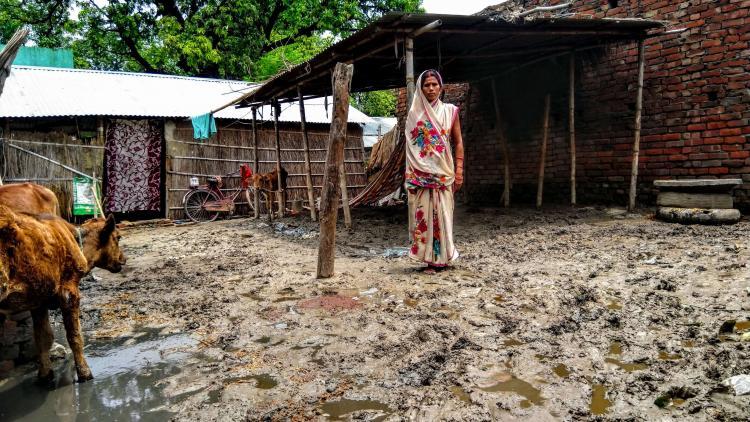COVID-19 in Rural India-XXXIX: Lockdown Has Affected Income and Food Security in Bihar’s Bairiya Village

File Photo.
This is the 39th report in a series that provides glimpses into the impact of COVID-19-related policies on life in rural India. The series, commissioned by the Society for Social and Economic Research, comprises reports by various scholars who have been conducting village studies in different parts of India. The reports have been prepared on the basis of telephonic interviews with key informants in their study villages. This report talks about the difficulties that residents of Bairiya in Bihar’s West Champaran district are witnessing amid the lockdown.
This article attempts to understand the effects of COVID-19 and the government-imposed lockdown on Bairiya village, which is in the West Champaran district of Bihar. According to the 2011 Census, the total population of the village was 1,479 individuals. Agriculture is the primary occupation of the majority of the village’s inhabitants, althoughsome villagers are involved in non-farm activities.Some farmers also work as agricultural labourers or take up non-farm work because their landholdings are small and their income from agricultural activities is insufficient.
The impact of the pandemic on agriculture
The major crops grown in the village during the rabi season are wheat, rapeseed/mustard, bajra and maize, as well as small quantities of peas, chickpeas, tur and masur. Around 77.8% of households involved in agricultural activities cultivate their own land, while 22.2% are involved in sharecropping on leased land in addition to farming their own land, usually because their own landholdings are too small to fulfil all their needs.
The first phase of the lockdown began just when the standing wheat crop in the village was ready to be harvested. Some farmers reported facing a labour shortage owing to the lockdown. Farmers who rely on combine harvesters from Punjab to harvest their crops reported that these machines and the drivers and technicians who accompany them arrived late this year due to the lockdown. In the absence of the machines, some farmers fell back on harvesting their crops using labourers and threshers, which increased the amount of time spent on harvesting. Rain and thunderstorms in the region also disrupted the harvesting of the wheat crop, and brought losses to some farmers.
Table : Status of Agricultural Activities Carried Out by Agricultural Workers
Source: Authorâs calculations
At the time of interview, the respondents said that the harvesting of the wheat crop had been completed. Around 55.6% of farmers had harvested the crop using family labour while the rest had used hired labour. A total of 77.8% of farmers said that the harvested wheat was solely meant for household consumption, while 22.2% offarmers said that they would have some surplus after setting aside sufficient wheat for household consumption. Three of these farmers sold their surplus wheat either to local traders or at the nearest market. All of them reported to have received only Rs 1,600 to Rs 1,700 per quintal, which is much less than the minimum support price (MSP) for wheat (Rs 1,925 per quintal) announced for this rabi season.
Peas, chickpeas, tur, masur grown in the village are meant only for household consumption. The respondents said that some farmers had sown maize in the rabi season, and had hoped to sell green maize at the market. However, the maize traders who usually buy this harvest were unable to travel to the local markets this year, and farmers have thus been unable to sell their maize. These farmers are now storing the harvested dry maize for household and livestock consumption.
According to the respondents, many farmers in Bairiya are engaged in subsistence agriculture, i.e., they grow crops solely for household consumption. A few respondents also rear livestock and sell milk. These respondents reported being unable to sell milk due to the closure of markets, sweet shops, local eateries, dhabas and restaurants, leading to a loss of income. They also reported finding it difficult to buy feed for their animals. Also, due to the informal nature of the milk business in the village, they said there is no fixed price for milk, as the price depends on where the milk is being sold. The price of milk sold in the village, for instance, is 25-30% lower than the price the same milk is sold for at a market. During the initial phases of the lockdown, farmers were unable to sell milk in the markets and the milk was retained for domestic consumption or sold in the village.
Impact on non-agricultural activities
During the first and second phases of the lockdown, all construction work came to a halt. It was resumed during the third phase of the lockdown, when some restrictions were relaxed in the district. Respondents who work as construction workers said they were still waiting to return to work as employers are now hiring fewer workers than before the lockdown.
Street vendors and street food stalls were not allowed to remain operational during the lockdown. Shops in the local markets were closed and people employed at these were without work. One respondent who is employed at a carpentry workshop said that the supply of wood had stopped during the lockdown and that he has no work now. Another respondent who is a tailor based in the local market also reported being out of work due to the closure of shopsduring the lockdown. A respondent who works as a helper at a cloth shop in the local market was also out of work as the shop was closed.
Some respondents said they had MGNREGA job cards, but reported being unable to get employment under the scheme.
Impact on the availability of essential commodities
According to the respondents, the prices of packaged foods remained the same during the lockdown but the prices of vegetables and fruits fell. Weddings and religious functions could not take place, and hotels and restaurants in nearby towns were closed, which caused a decline in demand for fresh produce and a fall in prices.Vegetable farmers have also been unable to take their produce to the mandi or to nearby urban areas to sell, so they are forced to sell vegetables at cheaper prices within the village, leading to a loss of income. The prices of vegetables likebhindi, pumpkin, bottle gourd, bitter gourd, tomato, tori and beans were all reported to fall within the range of Rs 5-15 for a kg.
The pandemic has affected not just the health of the inhabitants of Bairiya, but also their employment, income and food security. Although the distribution of rations through the public distribution system (PDS) is taking place, not all households have benefited. The last instance of food grain distribution (20 kg of wheat and 15 kg of rice per family under the Antyodaya) was in April. The respondents said that they are entitled to get 35 kg of rations, but they have only received 28-30 kg. They have not yet received their grain entitlements for the month of May.
Under the Pradhan Mantri Garib Kalyan Yojana (PMGKY), Rs 500 had been transferred to the accounts of 12 households who had Jan Dhan Accounts. An amount of money equal to the price of one LPG cylinder was transferred to households eligible for this under the Ujjwala scheme in the first week of May. Only six out of the nineteen farming households surveyed reported receiving Rs 2,000 under the PM-KISAN scheme at the beginning of May. The others said that they had received the first instalment due to them under the scheme, but they have subsequently been excluded from the scheme because their accounts are not linked with their aadhar cards.
Availability of essential services and banking facilities
Both the State Bank of India (SBI) and Central Bank of India (CBI) have one branch each within the village. There are also two ATMs, although the respondents reported that there is rarely cash available at these.
Throughout the lockdown, no interventions or initiatives seem to have been taken by the administration, NGOs or civil society with regard to spreading awareness about COVID-19 and its prevention. The villagers have relied on electronic or print media like TV, newspapers and social media for knowledge about the disease. There have also been no programmes undertaken at the panchayat-level to address the issue.
However, a quarantine centre has been set up on the premises of the village primary school.Anyone travelling to the village is mandatorily confined within the quarantine centre for 14 days, but the lack of proper screening facilities and the poor conditions at the centre (no proper sanitation, arrangements for food, and living conditions) have meant that people simply go home, thus creating the opportunity for the virus to spread through the community.
The COVID-19 pandemic and the extended nationwide lockdown have had a palpable impact on agricultural and non-agricultural activities in the village. Farmers were able to complete harvesting their rabi crops. However, those who sold the crops in the market had to sell at prices considerably lower than the MSP. Dairy farmers, vegetable growers, street vendors and local food stall owners are the worst hit due to the extension of the lockdown. Rations are being distributed, albeit irregularly, in the village and not all households in need have been able to benefit from this. Some households have received cash transfers under the PMGKY, Ujjwala and the PM-KISAN schemes, but many of the respondents have been excluded from accessing these benefits. There have been no programmes from the administration or the panchayat to create awareness about the pandemic in the village. The quarantine centre does not have the basic facilities necessary, and the quarantine protocol for people travelling to the village is not being adhered to strictly as a result.
[This report is based on interviews of 30 respondents across different households conducted in the second week of May. Nineteen respondents work in agriculture while the remaining eleven are construction workers, carpenters, retail shop workers and owners and street vendors.]
The author is Assistant Professor at B. R. A. Bihar University in Muzaffarpur, Bihar
Get the latest reports & analysis with people's perspective on Protests, movements & deep analytical videos, discussions of the current affairs in your Telegram app. Subscribe to NewsClick's Telegram channel & get Real-Time updates on stories, as they get published on our website.























